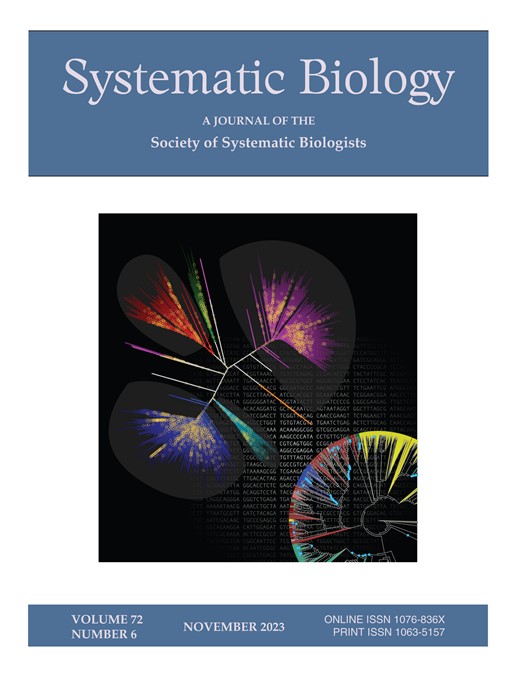UnFATE: A Comprehensive Probe Set and Bioinformatics Pipeline for Phylogeny Reconstruction and Multilocus Barcoding of Filamentous Ascomycetes (Ascomycota, Pezizomycotina)
IF 5.7
1区 生物学
Q1 EVOLUTIONARY BIOLOGY
引用次数: 0
Abstract
The subphylum Pezizomycotina (filamentous ascomycetes) is the largest clade within Ascomycota. Despite the importance of this group of fungi, our understanding of their evolution is still limited due to insufficient taxon sampling. Although next-generation sequencing technology allows us to obtain complete genomes for phylogenetic analyses, generating complete genomes of fungal species can be challenging, especially when fungi occur in symbiotic relationships or when the DNA of rare herbarium specimens is degraded or contaminated. Additionally, assembly, annotation, and gene extraction of whole-genome sequencing data require bioinformatics skills and computational power, resulting in a substantial data burden. To overcome these obstacles, we designed a universal target enrichment probe set to reconstruct the phylogenetic relationships of filamentous ascomycetes at different phylogenetic levels. From a pool of single-copy orthologous genes extracted from available Pezizomycotina genomes, we identified the smallest subset of genetic markers that can reliably reconstruct a robust phylogeny. We used a clustering approach to identify a sequence set that could provide an optimal trade-off between potential missing data and probe set cost. We incorporated this probe set into a user-friendly wrapper script named UnFATE (https://github.com/claudioametrano/UnFATE) that allows phylogenomic inferences without requiring expert bioinformatics knowledge. In addition to phylogenetic results, the software provides a powerful multilocus alternative to ITS-based barcoding. Phylogeny and barcoding approaches can be complemented by an integrated, pre-processed, and periodically updated database of all publicly available Pezizomycotina genomes. The UnFATE pipeline, using the 195 selected marker genes, consistently performed well across various phylogenetic depths, generating trees consistent with the reference phylogenomic inferences. The topological distance between the reference trees from literature and the best tree produced by UnFATE ranged between 0.10 and 0.14 (nRF) for phylogenies from family to subphylum level. We also tested the in vitro success of the universal baits set in a target capture approach on 25 herbarium specimens from ten representative classes in Pezizomycotina, which recovered a topology congruent with recent phylogenomic inferences for this group of fungi. The discriminating power of our gene set was also assessed by the multilocus barcoding approach, which outperformed the barcoding approach based on ITS. With these tools, we aim to provide a framework for a collaborative approach to build robust, conclusive phylogenies of this important fungal clade.UnFATE:用于丝状子囊菌(Ascomycota, Pezizomycotina)系统发育重建和多位点条形码的综合探针集和生物信息学管道
丝状子囊菌亚门是子囊菌纲中最大的分支。尽管这组真菌很重要,但由于分类群采样不足,我们对其进化的理解仍然有限。虽然下一代测序技术使我们能够获得完整的基因组进行系统发育分析,但产生真菌物种的完整基因组可能具有挑战性,特别是当真菌发生在共生关系中或当稀有植物标本馆标本的DNA被降解或污染时。此外,全基因组测序数据的组装、注释和基因提取需要生物信息学技能和计算能力,导致大量数据负担。为了克服这些障碍,我们设计了一个通用的目标富集探针集来重建丝状子囊菌在不同系统发育水平上的系统发育关系。从现有的Pezizomycotina基因组中提取的单拷贝同源基因中,我们确定了最小的遗传标记子集,可以可靠地重建一个健壮的系统发育。我们使用聚类方法来确定一个序列集,该序列集可以在潜在丢失数据和探测集成本之间提供最佳权衡。我们将该探针集整合到名为UnFATE (https://github.com/claudioametrano/UnFATE)的用户友好包装脚本中,该脚本允许在不需要专业生物信息学知识的情况下进行系统基因组推断。除了系统发育结果外,该软件还提供了一个强大的多位点替代基于its的条形码。系统发育和条形码方法可以通过一个集成的、预处理的、定期更新的所有公开可用的Pezizomycotina基因组数据库来补充。UnFATE管道使用了195个选定的标记基因,在不同的系统发育深度上都表现良好,生成的树与参考系统发育推断一致。从科到亚门的系统发育水平上,文献参考树与UnFATE生成的最佳树的拓扑距离在0.10 ~ 0.14 (nRF)之间。我们还在Pezizomycotina 10个代表性类的25个标本室标本上测试了以目标捕获方法设置的通用诱饵的体外成功性,该方法恢复了与该真菌组最近的系统基因组推断一致的拓扑结构。我们的基因集的鉴别能力也通过多位点条形码方法进行了评估,该方法优于基于ITS的条形码方法。有了这些工具,我们的目标是提供一个框架,合作的方法来建立强大的,结论性的系统发育这一重要的真菌分支。
本文章由计算机程序翻译,如有差异,请以英文原文为准。
求助全文
约1分钟内获得全文
求助全文
来源期刊

Systematic Biology
生物-进化生物学
CiteScore
13.00
自引率
7.70%
发文量
70
审稿时长
6-12 weeks
期刊介绍:
Systematic Biology is the bimonthly journal of the Society of Systematic Biologists. Papers for the journal are original contributions to the theory, principles, and methods of systematics as well as phylogeny, evolution, morphology, biogeography, paleontology, genetics, and the classification of all living things. A Points of View section offers a forum for discussion, while book reviews and announcements of general interest are also featured.
 求助内容:
求助内容: 应助结果提醒方式:
应助结果提醒方式:


